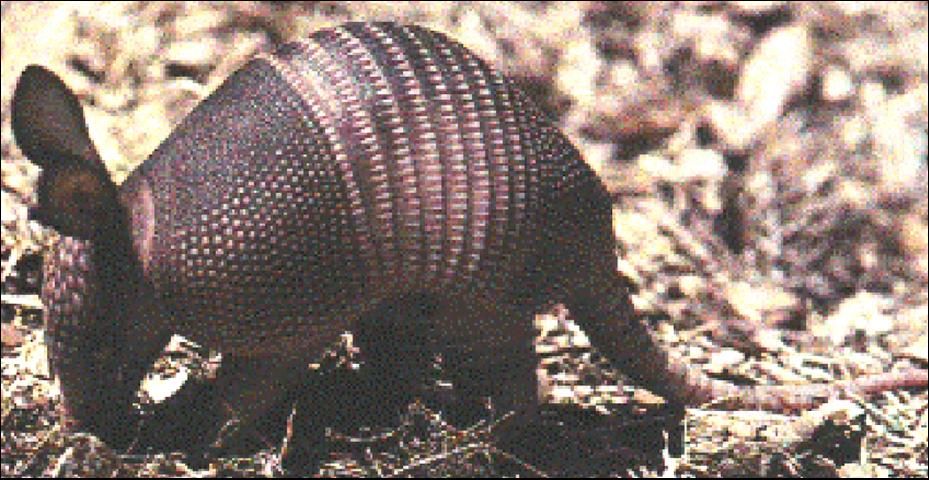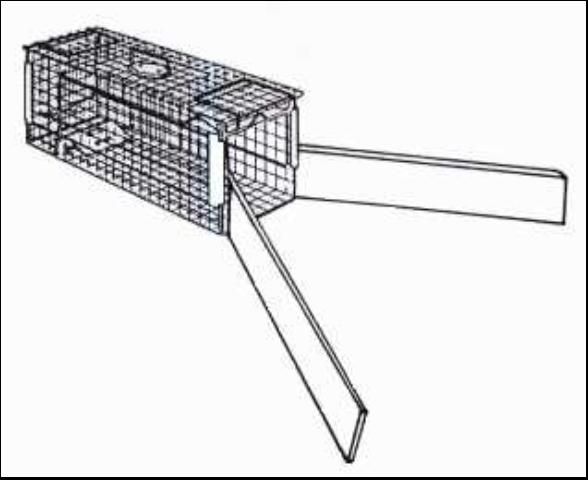Armadillos are prehistoric-looking animals that belong to a family of mammals found primarily in Central and South America. The earliest fossil ancestor of our North American armadillo occurred about 60 million years ago; it was as large as a rhinoceros. Our present-day nine-banded or long-nosed armadillo, Dasypus novemcinctus, is much smaller; adults normally weigh from 8–17 pounds (3.5–8 kilograms) (Figure 1). This species occurs in Texas and east, throughout the South. It occasionally is found in Missouri and South Carolina. However, cold weather limits the northern boundary of the armadillo's range.

Credit: Bill Kern
Armadillos were not always present in Florida. During the past century, they expanded their range from Texas into the Florida panhandle. From 1920 to about 1970, there were several introductions of armadillos into the Atlantic coast region of Florida. Then the panhandle and peninsular populations expanded until they merged. Armadillos are now found in uplands throughout Florida, except in the Keys and parts of the Everglades and Big Cypress swamp.
Description
Armadillos have a shield-like shell covered with horny scales. Joints in the shell are flexible, which enable the animal to bend and twist. Only the ears and belly of the armadillo are without bony armor (Figure 2). These peculiar animals have 28–32 peg-like teeth in simple rows well back in the mouth. There are no front teeth. Armadillos have poor eyesight and hearing, but a keen sense of smell. Both males and females are about the same size, look alike, and have similar habits. Despite their awkward appearance, armadillos are agile runners and good swimmers, and even have the ability to walk underwater across small streams.

Credit: UF/IFAS
Typical Habitat
Armadillos inhabit dense shady cover, such as brush, woodland or pine forests. Soil texture is also a factor in the animal's habitat selection. They prefer sandy or loam soils that are relatively easy to excavate.
Armadillos typically rest in a deep burrow during the day and become more active during the late evening, night, or early morning. These burrows are usually located under brushpiles, stumps, rockpiles, dense brush, or concrete patios, and are about 7–8 inches (18–20 cm) in diameter and can be up to 15 feet (4.5 m) long. Armadillos often have several burrows throughout their territory, but use only one to raise their young.
Reproduction
Although armadillos breed in late July, the 5-month gestation period is delayed, which results in the young being born in February or March. Only one litter is produced each year, and it always includes four identical young of the same sex because they develop from a single egg. The young look like the adults except that they are smaller and their armor coat remains soft and leathery for some time, becoming harder with age.
Diseases
Compared to other common mammals such as raccoon and opossum, armadillos are remarkably free of parasites. Twenty-six parasites and disease agents have been identified from armadillos in Florida. These include 2 arboviruses, 19 bacteria, 2 protozoans, 1 nematode, and 2 mites. All except the nematode and mites may also infect humans or other animals, but no severe outbreaks of these situations have been reported. Rabies has never been diagnosed in armadillos in Florida.
In 1971, a captive armadillo developed leprosy 17 months after it was inoculated with the bacterium Mycobacterium leprae obtained from an infected human. Subsequently, armadillos have been used in further study of this disease. Leprosy in wild armadillos has been reported at rates ranging from 0.5% to 10% in Louisiana, Texas, Mississippi, and Mexico. However, no infections have been found in the more than 2,500 armadillos examined in Florida. The relationship between infections in wild armadillos and in humans is not clear.
Causes of Death
Armadillos are one of the most common victims of highway mortality in Florida. The armadillo's instinctive response of jumping upwards when startled may be effective at avoiding a lunging predator, but not an automobile or truck passing overhead. Also, many are killed by dogs and coyotes.
Feeding Habits
These animals feed primarily on insects and their larvae. They also eat earthworms, scorpions, spiders, snails, and small vertebrates and their eggs. Reports of armadillo damage to birds' nests on the ground are rare. People cannot help but appreciate the fact that armadillos consume large amounts of armyworms, cockroaches, ants, wasps, flies, beetles, and grasshoppers. They have been known to dig up entire yellow-jacket nests. Armadillos usually search for food by rooting or digging in ground litter, but will occasionally eat berries and mushrooms.
Type of Damage Caused by Armadillos
Armadillos are, to some degree, beneficial because they eat adult insects and larvae. But their feeding behavior also can cause problems for property owners and managers. When looking for insects in the soil, armadillos dig numerous holes in golf courses, lawns, flowerbeds, and gardens. These holes typically are 1–3 inches (2.5–7.6 cm) deep and 3–5 inches (7.6–12.7 cm) wide. They also uproot flowers and other ornamental plants. Armadillo burrows under driveways and patios can cause structural damage; and burrows in pastures can pose a potential hazard to livestock.
Methods of Control
Recommended methods of control include:
- reduce watering and fertilizing lawns
- creating barriers (e.g., fences)
- live-trapping
- shooting offending individuals.
Reducing watering and fertilizing your lawn will reduce armadillo damage. A moist lush landscape is perfect for earthworms and insect larvae. Armadillos love earthworms. Sometimes watering adjacent areas may attract armadillos away from a site.
Where highly valued plantings are in need of protection, small fences may be used to keep the animals out. These fences should be approximately 24 inches (60 cm) above ground with the bottom of the fence buried 18 inches below the surface of the ground. The fence also should be slanted outward at about a 40° angle.
Several live-trapping techniques can be used to capture armadillos as they come out of their burrows. One is to firmly insert a 6-inch diameter PVC pipe into the entrance of an active burrow. Regular-sized armadillos will get stuck in the pipe as they try to exit. A nylon throw-net used for fishing can also be staked down so it covers the burrow entrance. Armadillos will get tangled in the net as they emerge. Another trapping technique involves burying a large bucket (larger than 5-gallons) in front of the entrance, and covering it with newspaper or plastic sheeting and a light layer of soil.
Because armadillos are nocturnal, all trapping techniques designed to capture armadillos emerging from burrows should be applied late in the afternoon and checked several hours after darkness.
Laying chicken-wire along a patio, driveway or house foundation will also discourage them from burrowing.
Armadillos also can be trapped in raccoon-sized, metal, cage live-traps (available from local pest control and feed stores) or in homemade box traps. Traps should be located near the entrance of burrows or along fences or other barriers where they might travel. This trap is most effective when "wings" (1 x 6 inch x 6 feet boards or other material) are added to funnel the animal into the trap (See Figure 3). The benefit of using baits with this trap is questionable. Suggested baits are live earthworms or mealworms in surrounding soil placed in hanging bags made of old nylon stockings. Other suggested baits are overripe or spoiled fruit. Armadillos are more likely to enter a cage trap when leaf litter or soil is placed over the wire bottom.

Credit: Prevention and Control of Wildlife Damage by University of Nebraska, USDA-APHIS, and the Great Plains Agricultural Council
Relocating problem animals to another area is not recommended. This approach only transfers the problem somewhere else, can enhance the spread of diseases, and upsets the natural balance in the area where the armadillo is released. Further, armadillos are not native to Florida and it is illegal to transport and release them.
Shooting is another method frequently used to control nuisance armadillos where it is legal to discharge a firearm. Recommended firearms are a shotgun with No. 4 to BB-sized shot or .22 or other small caliber rifle. It is illegal to use artificial lights to aid in the shooting of armadillos at night. Armadillo meat is edible if properly prepared and there is no daily possession or season limit on them.
Poison baits are illegal and ineffective. No chemical repellents or fumigants are registered for use in Florida.
References
Fitch, H.S., P. Goodrum, and C. Newman. 1952. "The armadillo in the southeastern United States". J. Mammal. 33:21–37.
Howerth, E.W., D.E. Stallknecht, W.R. Davidson, and E.J. Wentworth. 1990. "Survey for leprosy in nine-banded armadillos Dasypus novemcinctus from the southeastern United States". J. Wildl. Dis. 26:112–115.
Humphrey, S.R. 1974. "Zoogeography of the nine-banded armadillo Dasypus novemcinctus in the United States". Bioscience 24:457–462.
Ober, H.K., DeGroote, L.W., and R.F Mizell III. 2011. Baiting the Nine-banded Armadillo. WEC 317. Gainesville: University of Florida Institute of Food and Agricultural Sciences. https://edis.ifas.ufl.edu/uw362
Wolfe, J.L. 1968. "Armadillo distribution in Alabama and northwest Florida". Quart. J. Fla. Acad. Sci. 31:209–212.